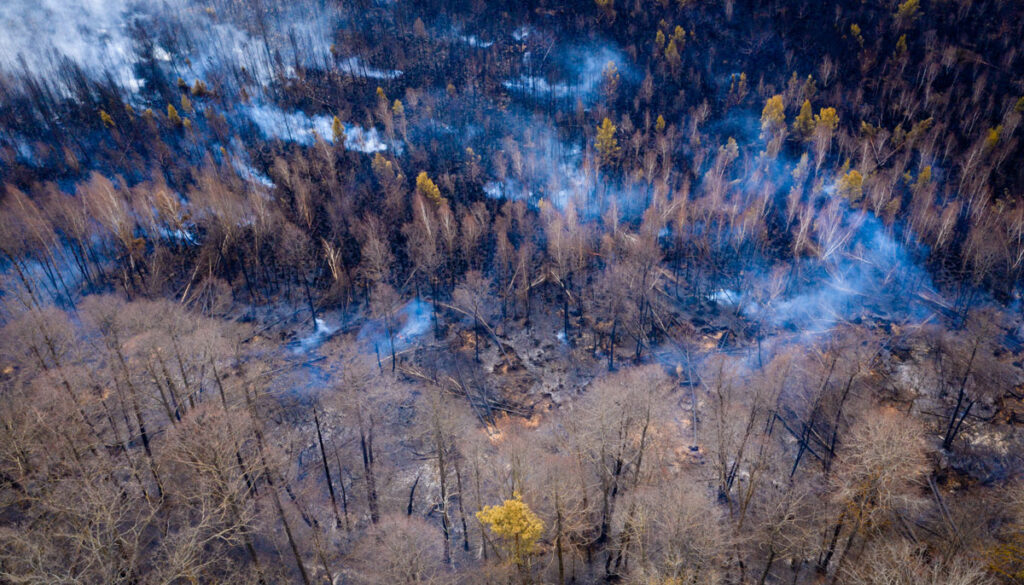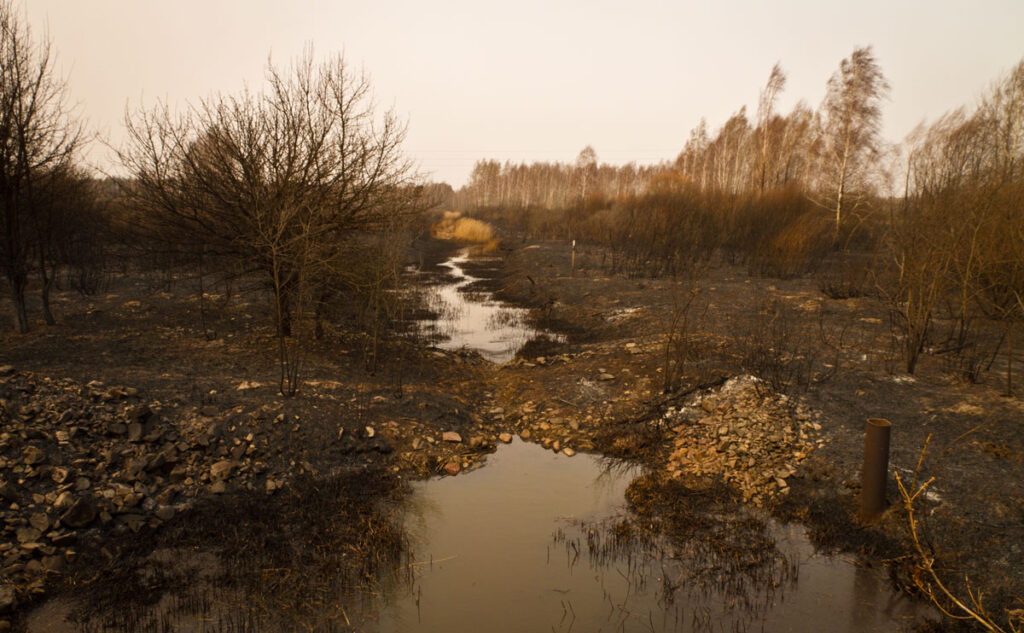In April 2020, wildfires tore through the Chernobyl Exclusion Zone in Ukraine. These fires—the largest since the 1986 Chernobyl nuclear disaster—burned some 870 square kilometers (336 square miles), about a third of the exclusion zone, according to one estimate, and raised concern about the redistribution of leftover radioactive contamination. A new study found that wildfires may make it easier for some contaminants to spread through waterways.
“But the impact of the wildfire is quite limited,” said study coauthor Yasunori Igarashi, a hydrologist at the University of Tsukuba in Japan. Overall, the work suggested that the 2020 wildfires caused little additional risk to the public.
In 1986, a reactor exploded at the Chernobyl (or Chornobyl in Ukrainian) Nuclear Power Plant, releasing 137Cs, a radioactive isotope of cesium, as a vapor into the air and flinging fuel particles containing 90Sr, a radioactive isotope of strontium, across the land.
Since the disaster, researchers have studied the tendency of these isotopes to be stirred up and released into the atmosphere. Under typical conditions, wind kicks up contaminated dust, moving tiny amounts into atmospheric aerosols. Controlled burn experiments suggest that wildfires can increase levels of atmospheric redistribution.
People tend to worry about the risk from these highly visible events, said environmental scientist Jim Smith of the University of Portsmouth in the United Kingdom. “But actually, the doses to people from inhalation are incredibly low,” he said. Firefighters experience the greatest risk of inhalation when fighting wildfires in these contaminated areas, said Smith, who was not involved with the new work but has collaborated with its authors.
Meanwhile, radionuclides can spread through the environment by hitching a ride through rivers. Researchers estimate that rivers shuttle tens to thousands of times what’s lofted into the atmosphere. But how these levels change when wildfires burn through a large chunk of the landscape has been unknown.

Clues in the Ashes
One concern is that 137Cs and 90Sr would be more likely to move into water after a burn. After the nuclear accident, radionuclides settled on trees, grass, and soil. Some 137Cs and 90Sr was removed by wind and rain, but plants also pull radioactive material into their tissues and take it up through their roots, said Luigi Monte, a retired researcher who worked on radioecological modeling at the Italian National Agency for New Technologies, Energy and Sustainable Economic Development in Rome and who was not part of the new study. “Consequently, long-lived radionuclides could remain entrapped in the branches and trunks of trees for several decades,” he said. When that vegetation burns, the ash and charred remnants can contain elevated levels of radionuclides that can be washed into rivers.
“The cesium and particularly the strontium is more available for transport. It can be washed out more easily.”
Igarashi and his colleagues analyzed ash and soil samples from six burned sites in the exclusion zone. Chemical tests revealed that a greater fraction of the 137Cs and 90Sr in ash could dissolve in water than the radionuclides in soil from burned areas. That suggests that the fire increased the mobility of these species, the researchers reported in Environmental Science and Technology. “The cesium and particularly the strontium is more available for transport,” Smith said. “It can be washed out more easily.”
The team also looked to long-running data collected in the Sakhan River catchment, which overlaps the burned area, to see whether 137Cs and 90Sr concentrations in the Sakhan River had changed after the fires. Levels of 137Cs remained below Ukraine’s drinking water limits and similar to previously recorded levels; 90Sr levels, on the other hand, fluctuated. Prior to the 2020 wildfires, 90Sr concentrations in the Sakhan River exceeded the country’s limits four times since 2001. In the 2 years after the fires, 90Sr concentrations surpassed the limit seven times. And although concentrations of 90Sr have naturally decayed over time, the highest river concentrations were observed after the wildfires.

The differences between the isotopes may be related to how the radionuclides interact with soil and sediments. The charge and size of 137Cs allow it to stick more easily to clay minerals than 90Sr does. “The cesium is easily captured by the soil, especially clay particles,” Igarashi said.
But we can’t yet definitively pin changes in 90Sr levels on the wildfires, Smith noted. “Disentangling all the environmental factors that caused the changes in the rivers is quite hard,” he said. Radionuclide levels are tested only every 2 weeks in the Sakhan. Other events such as flooding can influence river concentrations, as can snowmelt, which feeds groundwater and may prompt leaching of 90Sr from soil and ash.
“The increased levels of pollution of the Sakhan River water barely affect the level of contamination of water outside this zone.”
Overall, the impact of increased 90Sr concentrations in the Sakhan River is “negligible,” Monte said. Human activities are forbidden in the Chernobyl Exclusion Zone, and the water from the Sakhan is diluted outside the exclusion zone. “The increased levels of pollution of the Sakhan River water barely affect the level of contamination of water outside this zone.”
The findings may be useful for scientists studying other areas contaminated by radioactive isotopes, such as Fukushima, Japan, though the processes, landforms, and meteorological conditions would differ. Detailed work would be needed to identify the effects of fires or other mobilizing events in those areas.
—Carolyn Wilke (@CarolynMWilke), Science Writer

